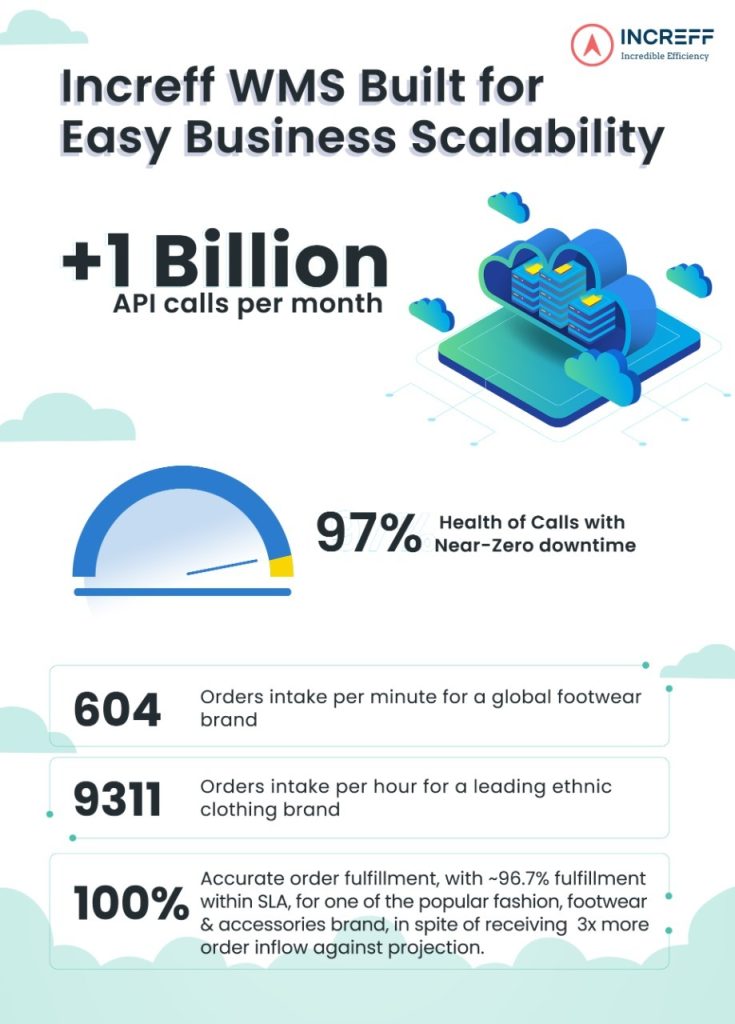
TTechnology
E-commerce Inventory and Order Management with Scalable WMS
Businesses demand rapid scalability from brands and retailers, especially in times of peak demand and business growth. When your website takes up to 5 seconds to load, there’s a 90% chance that your customers will bounce to a competitor’s site instead. During the season, there could be a significant ebb and flow in demand due to factors like weather, end-of-season sales, or festivity. Dealing with seasonality, therefore, requires a robust and agile warehouse management system to facilitate scalable operations just when they’re needed.
What is WMS?
A Warehouse Management System consists of software and processes using which retailers can control and administer warehouse operations. When the demand peaks, an ideal WMS must ensure that orders are captured and fulfilled accurately. A cloud-based WMS like Increff WMS can scale quickly as a business is growing or experiencing spikes in demand. A scalable WMS offers the right picking, packing, and inventory management even under pressure.
How to manage inventory and warehousing operations efficiently with WMS
- A warehouse management system allows you to match orders to facilitate accuracy in inbound and outbound logistics. By optimizing and automating the receiving process, a WMS ensures that errors are reduced.
- Using serialization or barcoding, a WMS keeps track of batches for effective inventory control, even during peak sales time, thus providing a consolidated view of the available inventory in real-time.
- Automating the processes for allocation, replenishment, picking, printing labels, and fulfillment, a WMS helps meet peak demand efficiently.
- It offers accurate and error-free picking to avoid wrong delivery, unnecessary return, and loss of sales.
- Managing reverse logistics efficiently in case a customer returns an item, a WMS facilitates the circulation of the product back to the sales channels immediately.
What are Economies of Scale in Warehousing?
Times of peak demand and drastic business growth provide retailers with a unique opportunity to sell huge volumes of products. This helps them accrue the benefit of “economies of scale” which essentially refers to a reduction in the per-unit cost of an item due to the huge volume of sales.
By providing efficient operations, centralized warehousing, and large storage capacity, warehouses provide economies of scale. For instance, instead of shipping individual packages, large batches of items are shipped to the stores at the same shipping cost, thus reducing the cost per unit item. Likewise, the storage costs per unit product decline during peak demand due to large volumes in the warehouse, as opposed to fewer items during periods of normal demand.
What is Order Management; Processing, and Fulfillment?
Order management is a vital part of operations for any e-commerce business. It starts with tracking and monitoring orders which can only be ensured with automation provided by a WMS system. This is especially true during rapid business growth and peak demand, to avoid errors and manage orders with accuracy and agility.
Order processing refers to the process or workflow from placement to delivery where reliability and accuracy are a must to ensure customer satisfaction. Picking, packing, sorting, shipping, and tracking are important steps that form part of order processing.
The entire process from when the sale takes place till the product is delivered to the customer is known as order fulfillment. This depends on 3PL partners and is augmented by an efficient WMS solution that helps drive the whole process without errors and inaccuracies.
Perfect Inventory and Order Management for Scalability
An inventory management system can be quite complex with a number of moving parts which can cause shortages if not handled well. Inventory management for a business that is scaling up begins with forecasting the demand as accurately as possible. Projections based on past data or recent trends in customer behavior can help have the right inventory to avoid under or over-stocking.
Having strong relationships with vendors and partners can help ensure seamless supply during peak demand. Vendors who have open stock inventory can fulfill orders as needed, this is on-demand manufacturing or Just-In-Time inventory management.
Finally, with automated order management systems, retailers can avail the benefits of APIs that offer flexibility, efficiency, and scalability. These enable a retailer to streamline operations while catering to huge customer demand.
Scalability is one of the most essential features of a WMS as it allows a retailer to meet the growing challenges of a burgeoning marketplace. Not having ample scalability means loss of sales, dent in a brand’s reputation, dissatisfied customers, and plummeting revenues.
20 April, 2022
TTechnology
5 Top Expert Tips to Unlock Inventory Efficiency…
In the ever-evolving landscape of online commerce, businesses face razor-thin profit margins, fierce competition, and…
31 July, 2023
9 months agoTTechnology
How to Succeed in Retail: Overcoming Supply Chain…
As we navigate through the uncertainty of our current times, the age-old adage, "necessity is…
5 July, 2023
10 months agoTTechnology
How does Increff WMS simplify your complex warehousing…
Data from the U.S. Bureau of Labor Statistics suggests that the employee turnover rate in…
24 April, 2023
1 year ago




